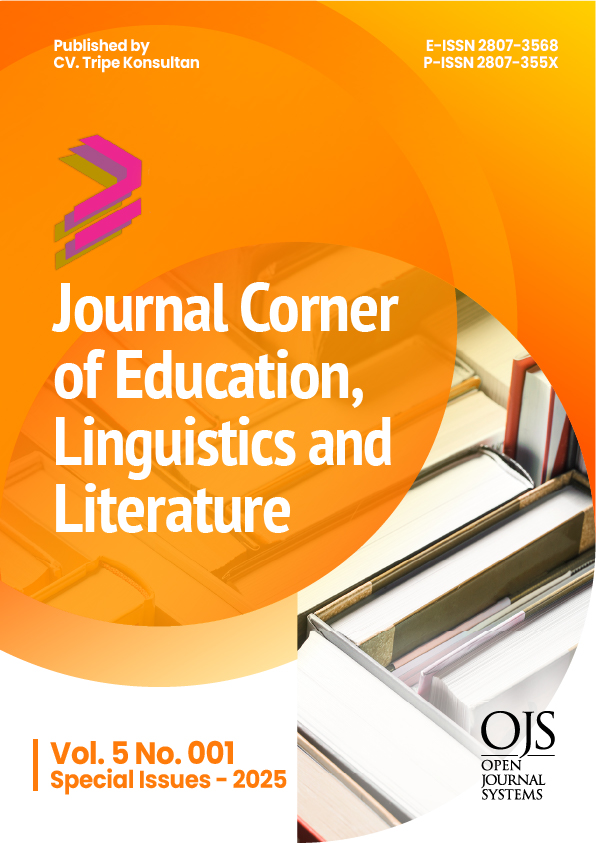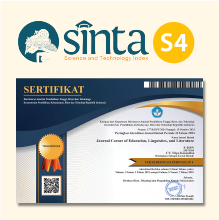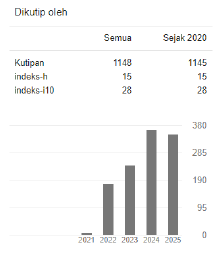Marketing Analysis of the Stamped Batik Industry to Enhance Worker’s Income in Purwokerto
 https://doi.org/10.54012/jcell.v5i001.579
https://doi.org/10.54012/jcell.v5i001.579
 Abstract views: 88
Abstract views: 88
 PDF downloads: 258
PDF downloads: 258
Keywords:
stamped batik, marketing strategy, UMKM, labor income, Purwokerto, creative industryAbstract
The stamped batik industry in Purwokerto is a cultural heritage with strategic economic value in creating jobs and supporting the local economy. This study aimed to analyze the marketing strategy of the stamped batik industry and its impact on increasing labor income in Purwokerto City. The research method employed was a qualitative approach, utilizing a case study, which involved 50 informants comprising MSME owners, workers, consumers, local government officials, and academics. Data were collected through in-depth interviews, field observations, and documentation studies, then analyzed using the Miles and Huberman interactive analysis model. The research results indicate that the stamped batik industry in Purwokerto comprises 47 UMKM, employing a total of 380 workers and generating a monthly production value of IDR 1.2 billion. The marketing strategies implemented include digital marketing (68% of UMKM), product diversification, and local brand development. The social media platforms Instagram (85%), Facebook (72%), and marketplaces (45%) are the main digital marketing channels. The implementation of marketing strategies has proven effective in increasing production volume by 35% and product sales value by 25-40%, which has a positive impact on increasing labor income through increased working hours, bonuses, and job stability. Supporting factors for industry development include government support, the availability of skilled human resources, adequate digital infrastructure, and a strong local culture. Meanwhile, the main inhibiting factors are limited capital, the quality of digital marketing human resources that still needs to be improved, competition with batik products from other regions, and dependence on imported raw materials. This study recommends improving the digital marketing capabilities of UMKM, providing continued government support in training and access to capital, and developing workforce skills in marketing and business management to create a sustainable business model for the Purwokerto stamped batik industry.
Downloads
References
Andriyanti, S., Syafriyandi, S., Evita, F., & Telaumbanua, F. (2024). Redesign of North Sumatra Ornaments in the Catalog with Circular Composition. KnE Engineering, 2024, 643–651. https://doi.org/10.18502/keg.v6i1.15454
Anita Yunikawati, N., Istiqomah, N., Jabbar, M. A., & Sidi, F. (2020). Model of Development Rural Tourism Batik in Banyuwangi: A sustainable Development Approach. E3S Web of Conferences, 208. https://doi.org/10.1051/e3sconf/202020805001
Basiroen, V. J. (2021). Creating Batik Lasem through a comparative study of Batik Lasem and Champa in the 15thto 19thcentury. IOP Conference Series: Earth and Environmental Science, 729(1). https://doi.org/10.1088/1755-1315/729/1/012064
Eskani, Haerudin, Setiawan, Lestari, Isnaini, A. (2021). Batik Fungsional Sebagai Salah Satu Strategi Pengembangan Industri Batik Dalam Memasuki Era Industri 4.0. Prosiding Seminar Nasional Industri Kerajinan Dan Batik 2019, 4(1), 233–245.
Firdaus, F., Setyono, P., Gravitiani, E., & Liquiddanu, E. (2025). Key Drivers and Barriers to Circular Economy Practices in the Global Textile and Fashion Industries: Sustainable Strategies for the Indonesian Batik Industry. International Journal of Sustainable Development and Planning, 20(1), 327–346. https://doi.org/10.18280/ijsdp.200130
Firmando, H. B. (2020). STRATEGI ADAPTASI PEMASARAN KERAJINAN TENUN ULOS PADA PASAR TRADISIONAL, MODERN DAN ON LINE DI TAPANULI UTARA (Studi di Kota Tarutung). AT-TAWASSUTH: Jurnal Ekonomi Islam, 5(1), 23. https://doi.org/10.30829/ajei.v5i1.7674
Ham, C., Tomasowa, R., & Hiemmayani, V. (2021). Natural dyes batik gallery with waste management in Kampung Palbatu Tebet. IOP Conference Series: Earth and Environmental Science, 794(1). https://doi.org/10.1088/1755-1315/794/1/012187
Handayani, W., Kristijanto, A. I., & Hunga, A. I. R. (2018). Behind the eco-friendliness of “batik warna alam”: Discovering the motives behind the production of batik in Jarum village, Klaten. Wacana, 19(1), 235–256. https://doi.org/10.17510/wacana.v19i1.673
Hartini, S., Manurung, J., & Rumita, R. (2021). Sustainable-value stream mapping to improve manufacturing sustainability performance: Case study in a natural dye batik SME’s. IOP Conference Series: Materials Science and Engineering, 1072(1), 012066. https://doi.org/10.1088/1757-899x/1072/1/012066
Indarti, Rahayu, I. A. T., & Peng, L. H. (2020). Sustainable Batik Production: Review and Research Framework. 390(Icracos 2019), 66–72. https://doi.org/10.2991/icracos-19.2020.14
Karsam, Widiana, M. E., Widyastuty, A. A. S. A., & Hidayati, K. (2022). Preservation, Standardization and Information Technology 4.0 of Traditional Gedog Tuban Batik To Be Competitive in Marketing During Covid-19. Theoretical and Practical Research in the Economic Fields, 13(1), 72–85. https://doi.org/10.14505/tpref.v13.1(25).06
Kurniati, E. D., Susilowati, I., & Suharno. (2019). Sustainable competitive advantage of smes through resource and institutional-based management: An empirical study of batik smes in central java, indonesia. Market-Trziste, 31(1), 61–82. https://doi.org/10.22598/mt/2019.31.1.61
Marodiyah, I., Taurusta, C., Febriansah, R. E., Ramdhani, A. P., Fidayati, A., Ardiansyah, R., & Nurdin, M. T. J. (2024). Optimization of production and marketing of stamped batik based on local wisdom through digital marketing. Community Empowerment, 9(11), 1716–1723. https://doi.org/10.31603/ce.12355
Masiswo, & Murti, R. S. (2021). Industri Kerajinan Batik Dan Hiasan Produk Wayang Kulit Pada Masa Epidemik Coronavirus (Covid-19) Di Desa Wukirsari. Prosiding Seminar Nasional Desain Dan Arsitektur (SENADA), 4, 324–330.
Megat Hanafiah, M. A. K., Ibrahim, S., Mohamad Subberi, N. I. F., Kantasamy, N., & Fatimah, I. (2021). Application of Cationic Surfactant Modified Mengkuang Leaves (Pandanus atrocapus) for the Removal of Reactive Orange 16 from Batik Wastewater: A Column Study. Nature Environment and Pollution Technology, 20(4), 1703–1708. https://doi.org/10.46488/NEPT.2021.v20i04.034
Outman, A., Deracinois, B., Flahaut, C., Diab, M. A., Dhaouefi, J., Outman, A., Deracinois, B., Flahaut, C., & Diab, M. A. (2023). Obtaining of New Antioxidant and Antimicrobial Peptides Derived from Human Hemoglobin by Peptide Hydrolysis and Comparison with These Obtained by Bovine Hemoglobin. March 2024. https://doi.org/10.20944/preprints202307
Raharjo, T., & Dafri, Y. (2020). Quilling Paper Stamp for the Efficiency of the Batik Production Process. Budapest International Research and Critics Institute-Journal, 5(3), 24492–24499. https://doi.org/10.33258/birci.v5i3.6472
Sari, N. M. W., Suwarsinah, H. K., & Baga, L. M. (2016). Kinerja Usaha Mikro, Kecil dan Menengah(UMKM) Gula Aren di Kabupaten Lombok. Jurnal Penyuluhan, 12(1),51–60.
Sunarjo, W. A., Manalu, V. G., & Adawiyah, W. R. (2021). Nurturing consumers’ green purchase intention on natural dyes batik during craft shopping tour in the batik city of Pekalongan Indonesia. Geojournal of Tourism and Geosites , 34(1), 186–192. https://doi.org/10.30892/gtg.34124-635
Untari, R. (2021). How do Batik Natural Dyes Crafter Spread Their Green Value (Case Studies on Batik Gemawang and Batik Warna Alam Si Putri). IOP Conference Series: Earth and Environmental Science, 940(1). https://doi.org/10.1088/1755-1315/940/1/012073
Utomo, H. S., & Susanta, S. (2020). The Effect of Digital Marketing Capability Against Marketing Performance with Innovation as mediation (Study on Batik SMEs during the Covid-19 Pandemic). 1(1), 166–173. https://doi.org/10.31098/pss.v1i1.193
Wiyana, T., Bahri, A. S., Zulkarnain, A., & Tomahuw, R. (2021). Basic of Creative Tourism: Batik as a Creative Industry. Proceedings of the 2nd Southeast Asian Academic Forum on Sustainable Development (SEA-AFSID 2018), 168, 19–23. https://doi.org/10.2991/aebmr.k.210305.005
Downloads
Published
How to Cite
Issue
Section
License
Copyright (c) 2025 Purwati Budi Lestari

This work is licensed under a Creative Commons Attribution-ShareAlike 4.0 International License.
All articles published in the Journal Corner of Education, Linguistics, and Literature are licensed under the Creative Commons Attribution-ShareAlike License (CC BY-SA).

















